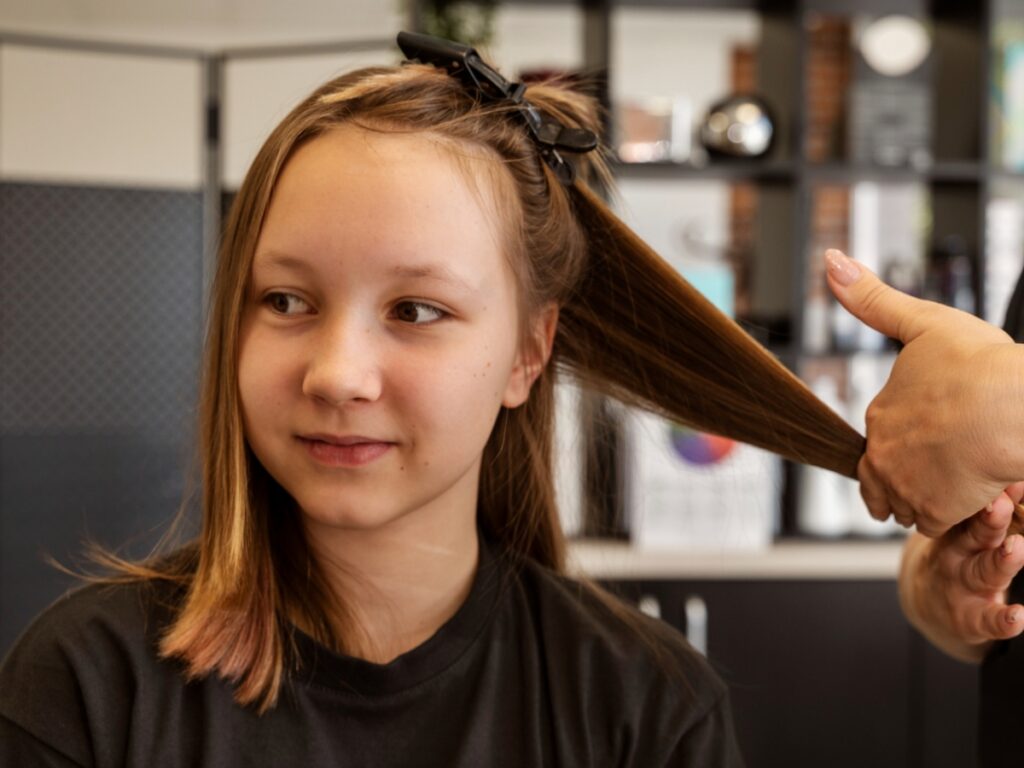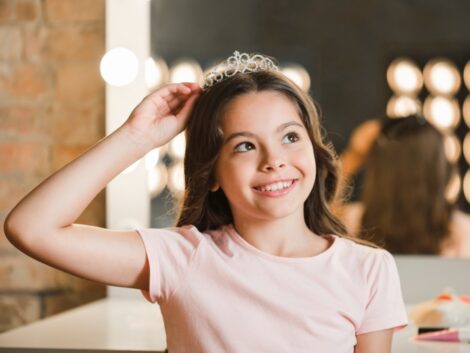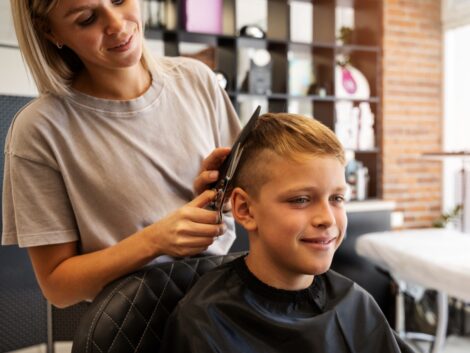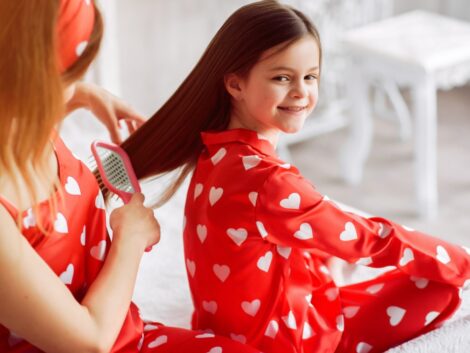Face shape can indeed influence the choice of kids’ haircut styles, just as it does for adults. Here are some general guidelines:
- Round Face: For children with round faces, hairstyles that add height and volume on top can create the illusion of a longer face. Layered cuts, pixie cuts, or side-swept bangs can work well.
- Square Face: Kids with square faces may benefit from softer, textured cuts to add some curves. Layered or asymmetrical styles can help soften the angles of their faces.
- Oval Face: An oval face shape is considered versatile, so many haircut styles can suit kids with this face shape. However, avoiding excessive length can prevent their face from looking too long.
- Heart-Shaped Face: Haircuts that balance the wider forehead and narrower chin are ideal for children with heart-shaped faces. Side-swept bangs or layered styles can achieve this balance.
- Long Face: Kids with long faces may want to avoid very long hairstyles, as they can elongate the face further. Shorter styles with some volume or bangs help balance the proportions.
Ultimately, it’s important to consider your child’s features, hair type, and preferences.
https://youtu.be/zXIofF28eYk?si=A-8Ezk-p5RtOdjTM
What haircut styles complement different face shapes in children?
Certainly! Here are some haircut styles that complement different face shapes in children:
Round Face:
- Pixie cut with side-swept bangs to add height and elongate the face.
- Layered bob to create the illusion of a more oval shape.
- Asymmetrical cuts add angles and definition.
Square Face:
- Textured, layered styles to soften the angles.
- Long, side-swept bangs add a touch of softness.
- A classic bob with a slight angle to frame the face.
Oval Face:
- Versatile and suitable for various styles, such as short bobs, long layers, or medium-length cuts.
- Straight or curly styles can work well for an oval face shape.
Heart-Shaped Face:
- Side-swept bangs to balance the wider forehead.
- Layered or shaggy cuts for a trendy and balanced look.
- Soft curls with a chin-length bob.
Long Face:
- Shoulder-length cuts with layers to add width and volume.
- Short or medium-length styles with bangs to visually shorten the face.
- Curly or wavy styles create the illusion of width.
Individual preferences, hair texture, and maintenance should also be considered when choosing a haircut for a child. It’s a good idea to consult with a hairstylist who can provide recommendations tailored to your child’s unique features and personality.
How can parents determine their child’s face shape to choose an appropriate haircut?
Determining your child’s face shape to choose an appropriate haircut can be done by following these steps:
- Observe Their Face: Start by looking at your child’s face when it’s clean and free from any hair covering. Pull their hair back if needed so you can see their face shape clearly.
- Use a Mirror or Photo: It can be helpful to have your child stand in front of a mirror or take a photo of their face. This way, you can analyze the proportions more easily.
- Identify Key Features: Pay attention to the following features to determine their face shape:
- Forehead: Is it wider or narrower than the jawline?
- Cheekbones: Are they prominent or less defined?
- Jawline: Is it rounded, square, or pointed?
- Face Length: Measure from the hairline to the chin.
- Compare to Common Face Shapes: Compare your observations to common face shapes, such as round, square, oval, heart-shaped, and long.
- Seek Professional Advice: Consider consulting with a hairstylist if you’re uncertain or want a more accurate assessment. They can help you identify your child’s face shape and provide haircut recommendations tailored to their features.
Remember that face shape isn’t the only factor to consider when choosing a haircut. Your child’s hair type, texture, and personal preferences should also influence the decision. Hairstylists can offer valuable insights and expertise to ensure the best haircut for your child’s unique features.
Are there haircut styles that enhance certain facial features in children?
Yes, there are haircut styles that can enhance or draw attention to specific facial features in children. Here are some examples:
Eyes
- Hair with bangs can frame and draw attention to the eyes.
- Layers, or side-swept bangs, can soften the face and highlight the eyes.
Cheekbones
- Shorter, textured cuts or layered styles can accentuate cheekbones.
- Cuts that add volume at the crown can create balance and enhance cheekbones.
Lips
- Shorter hairstyles that expose the forehead and frame the face can draw attention to the lips.
- Haircuts with layers around the chin area can complement the lips.
Forehead
- Bangs or fringed hairstyles can help cover a larger forehead.
- Tapered or side-parted styles can balance a prominent forehead.
Jawline
- Shorter hairstyles or bobs can highlight a well-defined jawline.
- Tousled, layered cuts can soften and draw attention away from a strong jawline.
Ears
- Short pixie cuts or styles that tuck hair behind the ears can emphasize ear shape.
- Longer, side-swept styles can cover the ears if preferred.
When choosing a haircut to enhance specific features, it’s essential to consider your child’s comfort and personal preferences. A skilled hair stylist can offer guidance and tailor the haircut to highlight the desired features best while taking into account your child’s unique characteristics.
How do hairstylists tailor haircut styles based on a child’s face shape and features?
Hairstylists tailor haircut styles for children based on their face shape and features by following these steps:
- Assessment: The stylist will start by analyzing the child’s face shape, including the forehead, cheekbones, jawline, and overall proportions. They will also consider the child’s facial features, such as eyes, lips, and ears.
- Discussion: The stylist will have a conversation with the child and parents to understand their preferences, lifestyle, and any specific concerns or limitations.
- Recommendations: Based on the assessment and the child’s desires, the stylist will suggest haircut styles that complement the face shape and features while considering practicality and maintenance.
- Customization: The hairstylist will customize the chosen haircut style to suit the child. This may involve adjusting the length, layers, bangs, or texture to enhance or balance specific features.
- Hair Type: The stylist will also take into account the child’s hair type, whether it’s straight, curly, thick, or fine. The haircut should work well with the natural texture and thickness of the hair.
- Maintenance: Stylists often consider the ease of maintenance, especially for active children. They may suggest styles that are easy to care for and style on a daily basis.
- Demo and Education: During the haircut, stylists may provide demonstrations on how to style and maintain the hair at home. They can also offer tips and product recommendations.
- Adaptation: If necessary, the stylist can make on-the-spot adjustments to the haircut to ensure it complements the child’s face shape and features.
Ultimately, the goal of the hairstylist is to create a haircut that not only enhances the child’s natural beauty but also makes them feel confident and comfortable. Effective communication between the stylist, child, and parents is crucial to achieving the desired results.
What are the considerations for siblings with different face shapes when choosing matching haircut styles?
Choosing matching haircut styles for siblings with different face shapes can be a fun and creative way to express their individuality while maintaining a sense of unity. Here are some considerations:
- Common Elements: Select a haircut style that has common elements or themes that can be adapted to each child’s face shape. For example, if both siblings want short hair, choose styles that suit their individual face shapes but share a common short length.
- Personalization: Tailor the haircut to each child’s unique face shape and features. One sibling’s haircut may involve layers to suit a round face, while the others could feature side-swept bangs to complement a heart-shaped face.
- Coordinate Length: Consider coordinating the length, but adapt the specific cut to suit the face shape. For instance, both siblings could have shoulder-length hair, but one might have a bob while the other has a layered cut.
- Shared Accessories: To create a unified look, siblings can use shared accessories, like hairpins, headbands, or hair ties, regardless of their different haircuts.
- Color and Styling: If the siblings have different hair colors or textures, you can use consistent styling techniques or color choices to create a sense of cohesion. For example, both siblings can have a beachy wave style or choose similar hair colors.
- Consult a Stylist: A professional hairstylist can provide guidance on how to adapt a chosen style to suit each sibling’s face shape. They can also help with color and styling suggestions for a harmonious look.
- Respect Preferences: Ensure that each child’s haircut reflects their personal preferences and comfort. It’s important that they feel good about their individual styles within the matching theme.
The goal is to create a sense of unity and fun while respecting each child’s unique features and preferences. The key is to strike a balance that allows them to express themselves while still sharing a common theme in their haircuts.
Lastly, check out the mane caper shop.





